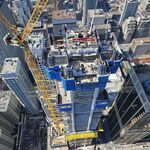DSC
Superstar
Member Bio
- Joined
- Jan 13, 2008
- Messages
- 20,015
- Reaction score
- 29,308
- Location
- St Lawrence Market Area
I wouldn't think fare evasion on that route is much higher than elsewhere. Heck, looking at the crowd riding the 143 - I suspect it's lower than average (I'm referring to the business attire)
You have touching faith that people in 'business attire' are less prone to free-loading!




